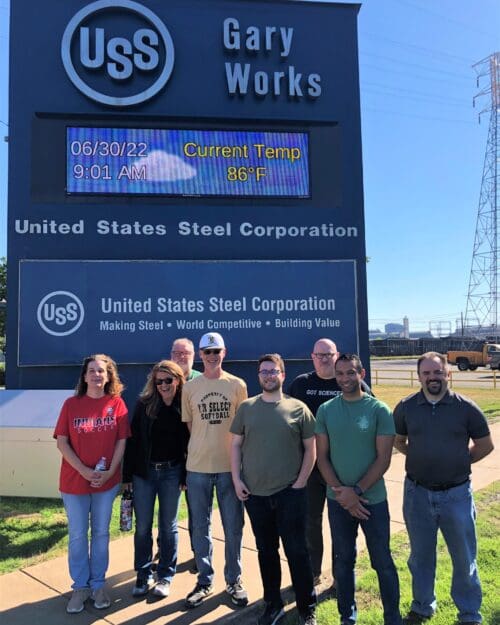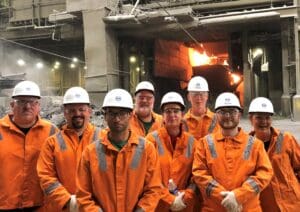NSF RET Teachers Visit U. S. Steel Gary Works

On June 30, 2022, eight high school teachers from the National Science Foundation’s (NSF’s) Research Experiences for Teachers (RET) program visited the U.S. Steel Gary plant, accompanied by CIVS Senior Research Scientist Jack Moreland. The teachers were from Portage, Whiting, Merrillville HS, Crown Point, Munster and Bloom High Schools. Mike Schwentor, USS Director of Operational Excellence, hosted the visit and welcomed all of the teachers. Al Klinger graciously guided the tour group through the plant.
During the six-week RET summer program, the RET teachers each worked on simulation and visualization research projects related to steelmaking. The tour of the Gary plant provided the faculty with an opportunity to see the steel-making process up close and personal. Seeing it firsthand helped them understand how their research in the CIVS lab relates to real-world problems and to understand the impact of their findings.
The faculty were excited to see things up close and to be able to talk and ask questions during the tour. During the tour, they saw molten iron pouring out of blast furnaces, huge ladles of iron combined with other components to produce steel of different chemical compositions, liquid steel poured into glowing hot plates, and rolling mills where slabs are reheated and extruded into long continuous strips that are rolled into huge coils. The teachers also saw high-tech equipment such as spectrometers used to analyze the chemical composition of steel samples and talked to various people throughout the plant. These teachers are conducting research projects related to the steel industry and developing lesson plans appropriate for their academic year courses so that they can pass on their experiences to their students.
NSF RET program at Purdue University Northwest consists of a six-week summer research program and full-academic year activities focused on using simulation and visualization technologies in “smart” manufacturing to increase energy efficiency, optimize production, predict mechanical failures, and improve safety and product quality. The goal is to enhance STEM education and stimulate high school and community college students’ STEM interest through a partnership with participant teachers, university mentors, and industry engineers using simulation and visualization technologies for innovative industrial solutions.
